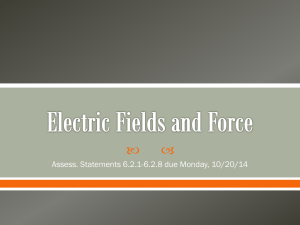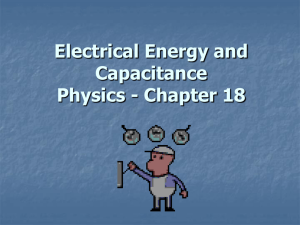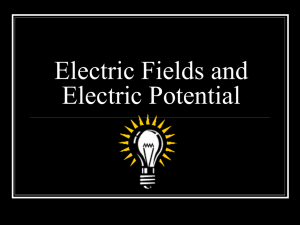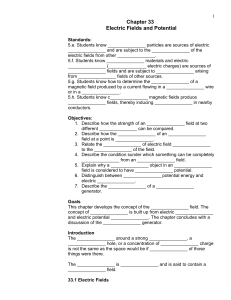PHY 132 – Outline of Lecture Notes h Section 1: Electric Fields
advertisement
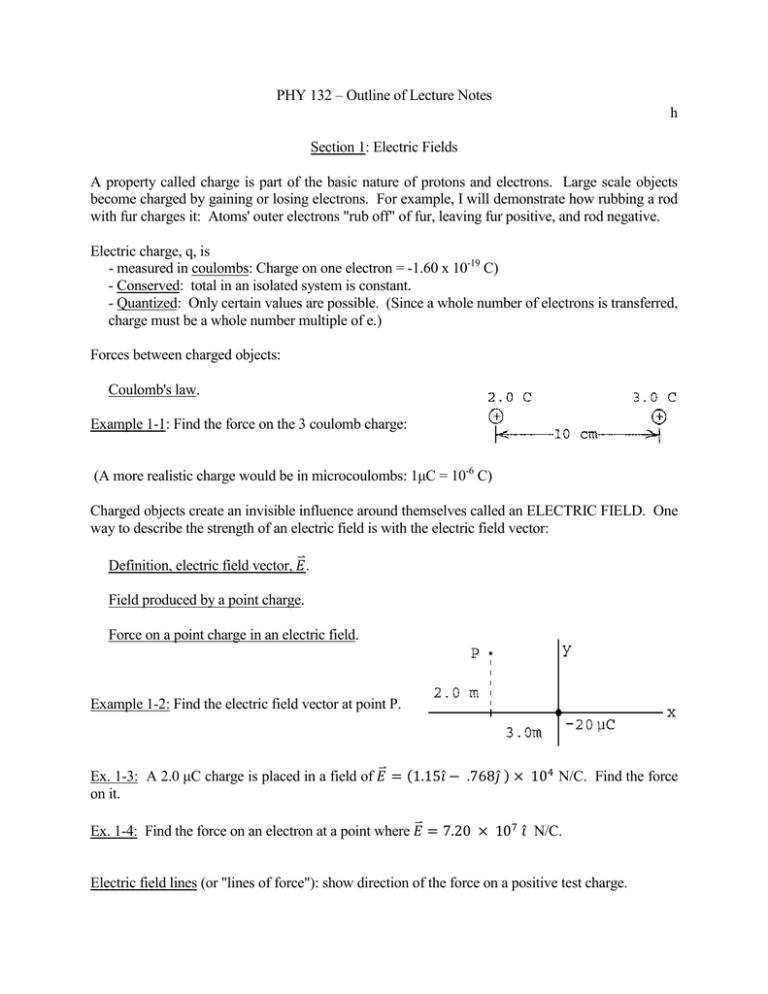
PHY 132 – Outline of Lecture Notes h Section 1: Electric Fields A property called charge is part of the basic nature of protons and electrons. Large scale objects become charged by gaining or losing electrons. For example, I will demonstrate how rubbing a rod with fur charges it: Atoms' outer electrons "rub off" of fur, leaving fur positive, and rod negative. Electric charge, q, is - measured in coulombs: Charge on one electron = -1.60 x 10-19 C) - Conserved: total in an isolated system is constant. - Quantized: Only certain values are possible. (Since a whole number of electrons is transferred, charge must be a whole number multiple of e.) Forces between charged objects: Coulomb's law. Example 1-1: Find the force on the 3 coulomb charge: (A more realistic charge would be in microcoulombs: 1μC = 10-6 C) Charged objects create an invisible influence around themselves called an ELECTRIC FIELD. One way to describe the strength of an electric field is with the electric field vector: Definition, electric field vector, ⃑ . Field produced by a point charge. Force on a point charge in an electric field. Example 1-2: Find the electric field vector at point P. Ex. 1-3: A 2.0 μC charge is placed in a field of ⃑ on it. ( Ex. 1-4: Find the force on an electron at a point where ⃑ ̂ ̂) N/C. Find the force ̂ N/C. Electric field lines (or "lines of force"): show direction of the force on a positive test charge. - 2- Note: Where field is stronger, lines are closer together. Superposition: If several charges are present, sum over all charges at other points on one charge = Σi i ⃑ at some point = Σi ⃑ i Ex. 1-5: Find the force on A and the force on B. Gravitational forces superpose the same way: - 3- Ex. 1-6: Find the force on the 3 kg. Ex. 1-7: (An electric dipole: pair of equal and opposite charges.) Find ⃑ at point P in terms of a, R and q. Conductors (examples: salt water, metals, acids): Contain many charged particles which are free to move. Insulators (rubber, glass, etc.): very few free charges . There is an electric current when there is a flow of charge. An electric field in a conductor pushes on the free charges, making them flow. If the field pushes on the charges in an insulator, they are held in place, so no current flows. - 4Section 2: Potential Review: work = = F s cosθ energy = stored up work Electric potential energy (UE): Energy can be stored in a charge by its position in an electric field. (Just as energy can be stored in a mass by its position in a gravitational field.) Another way of measuring a field's strength, instead of the force it exerts per unit charge, is the work needed to move a unit of charge through it: Definition of electric potential, V. Notice the unit for ⃑ can be called a volt per meter: Potential difference (between two points). Example: Each coulomb of charge flowing from a 12 V battery can do 12 J of work (deliver 12 J of energy). Each coulomb of charge flowing from a 120 V battery can do 120 J of work. Ex. 2-1: An electron is released from rest near the negative plate. Find the speed with which it strikes the positive plate. Cathode ray tube (television, computer monitor, etc): - 5Relationship between ⃑ and ΔV: It basically amounts to (volts per meter) times (meters) gives you volts. The details: Between infinite parallel plates, the field is uniform: Ex. 2-2: You apply 500 V to parallel plates .60 cm apart. How large is the acceleration of an electron between them? Ex. 2-3: Find the potential difference between points A and B in the uniform field shown. Potential Energy (electric or gravitational) of a point object: For this situation, - 6Electric potential energy, UE. Gravitational potential energy, Ug. Electric potential around a point charge, V. Superposition: If several charges are present, sum over all charges at other points U of one charge = Σi Ui V at some point = Σi Vi (Note: Treat and ⃑ as vectors. Treat U and V as scalars.) Ex. 2-4: Find V at point P from example 1-7. Ex 2-5: Find: a) potential energy of the 2 kg, b) the potential energy of the entire system. (For U of entire system, add up U for every way of pairing the charges.) Now, you do this one. It's kind of long; if you could start it at home, it would help: Ex. 2-6: Find: a) the electric field, E, where A is located, b) the force on charge A, c) the potential where A is located, d) the potential energy of charge A, and e) the potential energy of the entire system. - 7Section 3: Gauss's Law. Current. Flux: The amount of "field stuff" passing through an area, A. In a picture it's the number of field lines passing through A. This depends on 1) Strength of field, E (lines are closer together in a stronger field), 2) A (A larger area will catch more of them), and 3) Angle between A and ⃑ . Definition of Area Vector, . Definition of Electric Flux, ΦE. The density of lines represents the field's strength, E. E = Φ/A (if cosθ = 1) is sometimes called the flux density. Ex. 3-1: Find the electric flux through the hole. Ex. 3-2: Find the electric flux through a sphere of radius r, centered on a charge q. (The answer comes out ΦE = q/ε0.) Since the sphere is a closed surface, there is no way to get from the inside to the outside without passing through it and being counted. So, q/ε0 is all of the flux which the charge gives off. All of the flux is also what would pass through any other closed surface, so this result is true in general. - Gauss's law. Example: Φ still = q/ε0. Example: Φ = 0 because no charge inside. - 8- Ex. 3-3: Show that the field outside a uniformly charged sphere is . To find E from Gauss's law: 1. Decide what the field looks like. (Field lines point away from + charges.) 2. Pick a gaussian surface which the field point lies on, and which has the same symmetry as the charge. 3. Find the flux through the surface. 4. Set the flux equal to q/ε0. 5. Make any necessary substitutions, solve for what you need. Ex. 3-4: Find E a distance above an infinite sheet, with a uniform charge per unit area, σ. Notice, from the answer to that question, that the total field between two oppositely charged plates is E = Eupper + Elower = σ/ε0. If the plates are finite instead of infinite, you can substitute in σ = Q/A, giving E = Q_ ε0A (as used in section 4.) Ex. 3-5: a. A long copper pipe has a radius of 1.0 cm. How much charge per unit area is needed on it to have a field of E = 3.00 x 106 V/m 1 mm beyond its surface (R = 1.1 cm)? b. What is E at R = .90 cm? Ex. 3-6: This cube is an imaginary surface, 40.0 cm on each side. Three charged sheets (not shown) create an electric field whose components perpendicular to the cube’s faces are as indicated. (Cosθ = 0 for the parallel components, so they don’t matter.) How much charge is enclosed in the cube? - 9Now, you work on this one in class, with me and other students helping you: Ex. 3-7: Consider an imaginary cube, 1.5 m on each side, within a uniformly charged insulator. Throughout this region, the electric field, E, points toward the right, and the charge per unit volume is ρ = 3.4 nc/m3. If the magnitude of the electric field all over the left side of the box is E = 214 V/m, what is E on the right side of the box? - 10Section 4: Definition of electric current, I A charge dq flows through the cross section shown in a time dt. Ex. 4-1: 1.0 x 1021 electrons flow through a headlight in 30 seconds. Find the current. Ex. 4-2: The current in a wire varies according to I = 2e-5t, where I is in A and t is in s. How much charge moves through a cross section between t = 0 and t = .25 s? Resistance, R: As charged particles (such as electrons) move through a material, they collide with the surrounding atoms, losing energy and heating the material. In this way, the material resists the current. (Analogous to friction: changes electrical energy into heat.) Ohm's Law It can be helpful to compare electrical charge to water, wires to pipes, and so on: A battery's "voltage" is related to how hard it pushes the charges in a wire, so it is like the amount of pressure from a pump. Current (amps) is the rate that charge flows through the wire. Coulombs per second through a wire would be like gallons per second of water through a pipe. Resistance involves factors like how big around the pipe is. Ex. 4-3: Find the potential at points A, B, C and D. convention, ground is V = 0.) (By - 11Some details on resistance: Consider a substance containing free particles of charge q. (If it's a metal, for example, we'd be talking about electrons.) A = cross sectional area they flow through n = number of free charges per unit volume vd = drift velocity of the charges. (The speed of their net motion, superimposed on their much faster, random thermal motion.) Definition of current density, Relationship between current density and drift velocity Ex 4-4: 2.5 A flows through a copper wire 1 mm in diameter. Find the drift velocity of the electrons. (n = 8.49 x 1028 m-3 for copper at 300K.) Resistivity, ρ (ρ is a property of just the material. Resistance depends on the length and crosssection of the wire as well.) Electrical conductivity, σ E J Ex 4-5: A heating element for a toaster oven is to have a resistance of 24 Ω and a length of 2.0 m (before being coiled up). What diameter of nichrome wire should be used? Capacitors: E and V between oppositely charged parallel plates Ex. 4-6: 1000 V is applied across these plates. Find the charge on each. - 12- Capacitors, like the parallel plate capacitor in the previous example, store charge. (The electrons on the battery's negative terminal, for example, repel each other. Connecting to one of the capacitor's plates gives them someplace where they can get farther away from each other. They are also attracted by the positive charge which is accumulating nearby on the other plate.) With any kind of capacitor, Q = (some constant)V like in ex. 4-6. Definition of capacitance, C Capacitance of a parallel plate capacitor in a vacuum Ex. 4-7: Two 1 m2 plates are placed 1 mm apart in a vacuum. Find a. their capacitance, and b. the charge on each if connected to a 12 V battery. Capacitor combinations: Parallel: Series: Resistors: As explained in sec. 5, Parallel: 1 1 1 ... Req R 1 R2 Series: Ex. 4-8: What is the equivalent resistance? Req = R1 + R2 + ... - 13Review for Exam 1: My exams have five parts, each worth 25 points. The best four you do will be counted. So, the best strategy is to do all five parts, and let me cross out the low grade. These questions were chosen because people often need help with them. Do not expect the actual test to be very similar to this one; you need to study everything we covered. 1. Find the electric field vector, ⃑ , at the origin. Ans: 1150 ̂ V/m 2. The voltage applied to a 5.00 Ω resistor varies according to V = 100 cos(377t) where V is in volts and t is in seconds. How much charge flows through this resistor between t = 0 and t = .00100 s? (Hint: Remember that V = IR and that I = dq/dt.) Ans: .0195 C 3. Two latex spheres are released from rest in a vacuum with their centers 1.00 mm apart. Each has a radius of 1.30 μm, and a mass of 1.20 x 10-15 kg. One has a charge of e, the other's charge is -2e. Find the speed of each sphere (the speeds are equal) when they collide. (Hint: use conservation of energy.) Ans: .384 mm/s 4. Charge, of uniform density 80 nC/m3, is uniformly distributed throughout a long cylinder of radius 3.00 mm. Find the magnitude of the electric field at a point 2.00 mm from the center. 9.04 V/m 5. Short answer, 5 points each: a. Consider two imaginary hemispheres, both centered on an electron. i. How does the flux through one surface compare to the flux through the other? ii. How does the field strength, E, on one surface compare to E on the other? b. Two pieces of graphite are connected to a battery as shown. The second piece is twice as long, and has twice the cross sectional area. i. How do the currents in R1 and R2 compare? ii. How do the current densities in R1 and R2 compare (not too close to the ends)? - 14- c. If a proton was at point P, what would the direction of the force on it be? (Give an approximate value for θ, where 0 means right, 90 means up, 180 means left, etc.) d. How much work is done as .25 coulomb falls through a 500 V potential difference? e. The choice of where potential and potential energy equals zero is arbitrary. What choice was made in deriving the formula V = (1/4πε0)(q/r)? (The potential around a point charge.)


